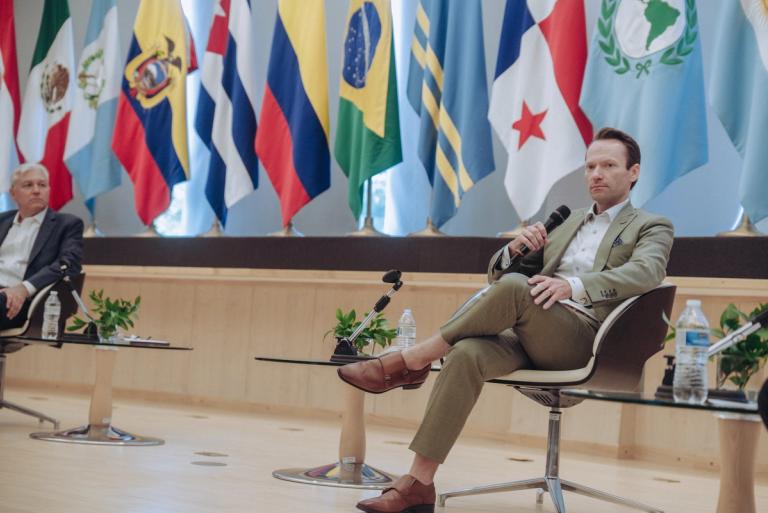Blog Article
Parliamentarians the World Over Converged on Panama City: Here is What We Told Them
Author
Seth Hertlein
Publishing date
Policy
Regulation
In late June 2021, the Parliamentary Intelligence-Security Forum held its 18th global meeting at Parlatino, the Latin American Parliament, in Panama City, Panama. Over 2,100 ministers of parliament, AML officers, and other government officials from 49 countries attended in-person or online. The event agenda centered around examining the intersection of illicit finance and emerging technologies.

Seth Hertlein, SDF Head of Policy & Government Relations, was invited to speak on a panel focused on illicit finance and blockchain, which Jackson Mueller, Director of Policy & Government Relations at Securrency, moderated.
Jackson Mueller (JM): What is the role of cryptocurrencies on the Stellar network, and how are they different from the underlying blockchain technology?
Seth Hertlein (SH): Thank you, Jackson. This sounds a bit like the classic “blockchain but not crypto” debate. Lumens, the native crypto asset on Stellar, play an important role in the functioning of the network, but they're really not the point. The majority of the value transferred across the Stellar network is fiat to fiat in the form of an exchange of one fiat-backed stablecoin for another. Sometimes, lumens serve as an intermediate step in such an exchange to provide the lowest cost payment path for users. That and network security are the two primary functions of XLM on Stellar. Both of these functions are not really affected by trading price, so we just don't spend a whole lot of time worried about Lumens themselves.
JM: Why is it important for policymakers and regulators to understand the distinction between crypto and blockchain as they look to apply some enhanced regulatory structures around this space?
SH: This is where we start to see a disconnect between how we as innovators and builders in the blockchain space view the network and how regulators see it. That disconnect, I think, is that while we're focused on financial inclusion and remittances, let’s face it, those aren't exactly the sexiest topics in the world. And so there's a temptation for regulators and the media to get distracted by the shiny objects - financial crime or price speculation - and lose sight of the real purpose and benefits of these networks.
I think there's a tendency for regulators to overestimate the risk or the potential for harm with these new technologies while underestimating the utility and the benefits that they provide.
JM: It does seem that blockchain supporters and skeptics often talk past each other. On one hand, industry stakeholders often talk about how blockchain technology brings significant transparency to markets. On the other hand, skeptical policymakers often claim that these technologies simply enable illicit finance. So, who's right and who's wrong? Is there a right or wrong?
SH: I think it's really important to set the table here with some facts and data. One of the leading blockchain analytics companies is a firm called Chainalysis. Chainalysis has a number of contracts with U.S. federal agencies. They also publish, every year, a crypto crime report. In their most recent crypto crime report, Chainalysis found that one-third of 1% (0.34%) of cryptocurrency transactions involved some element of criminality; one-third of 1%! A tiny fraction. The actual number was 0.0034. And so anyone who would suggest that cryptocurrency is predominantly used for money laundering, for example, is simply misinformed. The data just doesn't bear that out.
JC Boggs added, “[A]nd the illicit activity in the economy as a whole through traditional financial intermediaries or traditional fiat currency is on the order of 2% to 5% of global GDP, so a much higher number.”

SH: Furthermore, Chainalysis found that the majority of crypto crimes last year were garden-variety investment scams - things like Ponzi schemes. And while Ponzi schemes are certainly undesirable, that's not what we're here to talk about today. And that means that only a tiny fraction of a tiny fraction of cryptocurrency transactions involve crimes such as money laundering or terrorist financing.
SH: I don't say this to suggest that we should all just ignore it or that it's not a legitimate problem. Money laundering is bad and some very small amount of it does make use of cryptocurrencies. But, I would push back against some of the knee-jerk policies we've seen from policymakers around the world that are premised on false assumptions about the prevalence of money laundering in cryptocurrency. Based on the data, such overreactions are a disproportionate response to the scope of the problem.
JM: Let me ask a follow-up question to this. The industry has said to regulators as far back as I can remember, "Look, illicit financing isn't really happening in our markets. Look at the traditional markets. There are orders of magnitude more there." But, if I'm a policymaker and industry comes in my office saying, "Hey, look, we’re not so bad. There are bigger problems somewhere else." That probably doesn't convince me at the end of the day. What does the industry need to say to change the conversation?
SH: I totally agree, Jackson. If we walk into a policymaker's office and say, "Well, look over there. There's more crime in traditional finance or in fiat currency,..." even if it’s true - and in this case it is - but, if that's your argument, if you're just saying that we're less bad, you're losing, right?
JM: Right.
SH: That's just not a compelling story. And so, as an industry, I think we need to flip that script. We have to do a better job of communicating the benefits, the real-world uses, the utility of the technology. Your colleague at Securrency, Patrick Campos, said this to me once and it really stuck: Once upon a time in the American West, it was very common for trains to be robbed. It was very common for banks to be robbed. Certainly, one of the ways to prevent train robberies and bank robberies was to ban railroads and banks. But nobody ever suggested that. Why not? Well, because the value of railroads and banks was obvious, so that was never contemplated as a potential solution.
SH: In the same vein, we could just as easily say today, “There’s an awful lot of illicit activity in fiat currency - maybe we should abandon fiat,” but no one would take you seriously. So why is banning cryptocurrency being contemplated by serious-minded people? I think the answer is because it's harder to communicate the value of blockchain in a way that’s as obvious as the value of railroads in the Old West. And so that's what we need to do a better job of - making the value of blockchain today as intuitive as the value of railroads in the 1800’s.
JM: I’ve got to move on and get to the bigger elephant in the room - transparency vs. privacy. For years now, industry has continually spoken about transparency and the benefits to market integrity from adopting distributed ledger technology. But it also seems like, as soon as policymakers and regulators attempt to shine more light on this space, the industry starts screaming about violations of privacy. And so on one hand, the industry is talking about transparency, but then on the other, they advocate against efforts to unmask certain financial information that could be useful to law enforcement. Is that a fair analysis? And in particular, is there an effective balance between transparency and privacy in blockchain?
SH: Yeah, great question. I really think that is the issue. Transparency versus privacy, in a sense, is the reason we're all here today. It's the reason that the [Parliamentary Intelligence-Security] Forum exists. And while I suspect that most of the folks here today and most of the folks tuning in probably lean toward the transparency side of the spectrum, the reality is that it's very context-specific. Here's a crude example: Jackson, say that you're in the market for some new windows and I'm selling windows. Say I offer you a shiny, new, crystal clear window and an old, cloudy one. Which would you choose?
JM: I'd pick the clear window.
SH: Of course you'd pick the clear window. But what if the window you need is for your bathroom?
JM: Good point.
SH: The example could be better, but my point here is that context matters. Sometimes transparency is more important; sometimes privacy is more important. But fortunately, this isn’t new territory. It reminds me of a debate we had in the early days of the internet. In the early days, the basic protocol that the internet ran on was called HTTP. HTTP was a revolutionary innovation, but it had one critical flaw: HTTP was not encrypted. And since it wasn’t encrypted, it wasn't private. And since it wasn't private, it wasn't secure. This started to become a real problem with the advent of e-commerce, when people began typing their credit card numbers and bank account numbers into websites on the internet.
SH: And so, because HTTP wasn't encrypted, anybody with a little bit of technical know-how could intercept your internet traffic, could snoop on everything you were doing online, and that posed real problems. The solution was an upgrade to that protocol, which is called HTTPS. Colloquially, the S stands for secure. And that security comes from encryption. So now, the traffic between your computer and the web server you're interacting with is encrypted if you use HTTPS.
SH: At the time, law enforcement cried foul. They said, "How are we going to catch the bad guys if all of their online traffic is encrypted?" Undoubtedly, that probably did make things a little bit harder for law enforcement in some cases. But here's the important part: it actually prevented far more crime than it enabled because it also blocked the bad guys from being able to steal your information in the first place. That's an example where transparency isn't always good. Sometimes privacy means security, and sometimes privacy can actually prevent more crime than it enables.
JM: Let me just end with this question, because I think it's on the minds of everyone here: El Salvador. Let's talk about, real quick, their effort to adopt Bitcoin as legal tender. We're also seeing developments in Panama with similar legislation that could be introduced as soon as July. What do you make of all this?
SH: It's going to be a fascinating experiment, if nothing else. I think what's motivating this, at least in part, is the problem of the unbanked. According to the World Bank 1.7 billion people around the world don't have access to a bank or traditional financial services. Most of those people, or a lot of them, certainly, have access to mobile phone technology - maybe not smartphones, but feature phones. Blockchain-based solutions offer real potential to reach those populations - to enable them to access financial tools and services that they otherwise wouldn't be able to.
SH: About 70% of the population in El Salvador is unbanked. It's a high remittance country, and remittances through traditional rails can be very costly, slow, and inefficient. I think there's a real potential for blockchain technology to benefit countries like El Salvador. And I think that's why more countries are taking a serious look at it.

The text above was adapted from a panel discussion and has been edited for format and brevity. The full panel discussion can be viewed here.
More videos from the event can be viewed here as well.